Red is a color which anybody will fall in love with. Color red symbolizes love and passion. So, how wonderful would it be to add red succulents in your succulent garden.
Be it a succulent garden where you have grown ordinary green succulents or any other succulent garden where you have grown rest of other colorful succulents.
Red succulents would be great picks for any color palette or centerpieces, living walls or even for fairy gardens as well.
If you are into ordinary succulents gardening, you may be bored and fed up with seeing the regular green colored succulents every day.
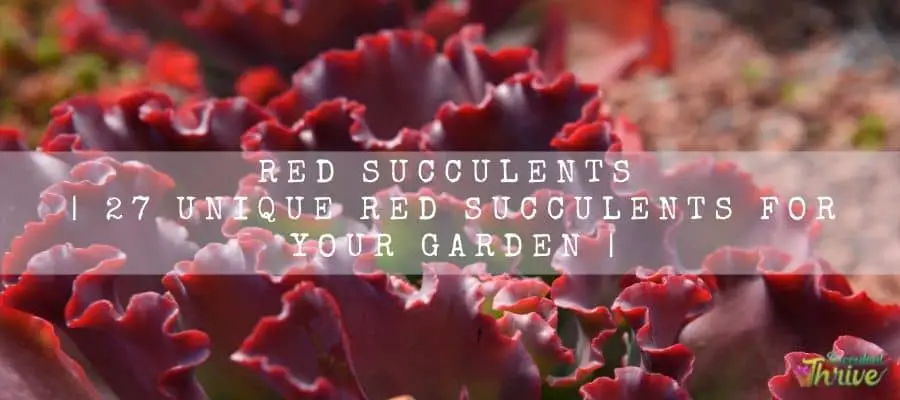
You might think succulents do not produce attractive flowers nor they have attractive foliage also.
However, this is something which you could argue since many succulents inherit their own unique beauty. Chances are that these succulents could produce flowers in numerous colors as well.
However, if you want to be innovative and if you are someone who wishes to add a reddish vibe to your garden.
Why not consider growing red succulents? So, if you are wondering what type of red succulent you wish to grow, I am sure this article would help you out.
We have elaborated on several red succulents which would be very useful for you. So, keep on reading this article.
I am sure you will fancy having a couple of them after reading this article. Chances are that you will end up growing all of them too.
Echeveria agavoides ‘Romeo’
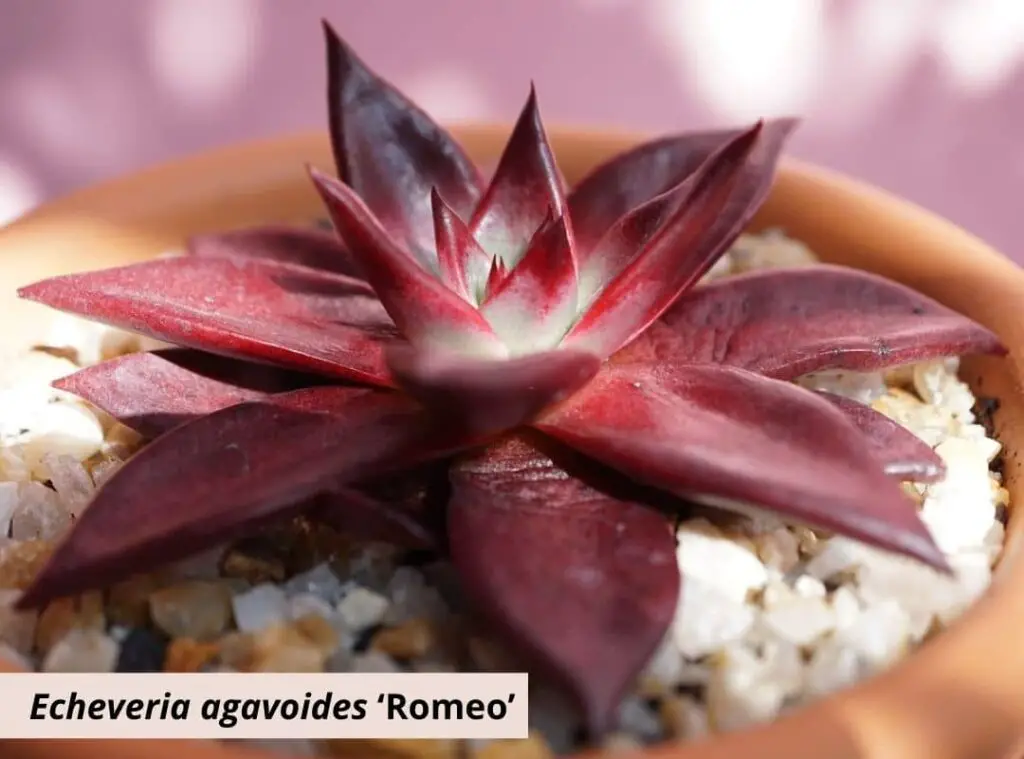
Echeveria agavoides Romeo is a fabulous looking decorative plant which you could grow indoors as well as outdoors.
Romeo are hardy plants, and you could grow them with minimum maintenance as well. Romeo propagate from leaves which are plump, sharp andred in color.
They would usually produce radiant rosettes which could be about six inches in height and twelve inches in diameter.
You could spot them producing flowers with petite flowers along with a vibrant hue. They have a close resemblance to Agave as well.
USDA hardiness zones 9b-11b are their ideal growing zones. Mexico is their native country.
Sempervivum ‘Red Lion’
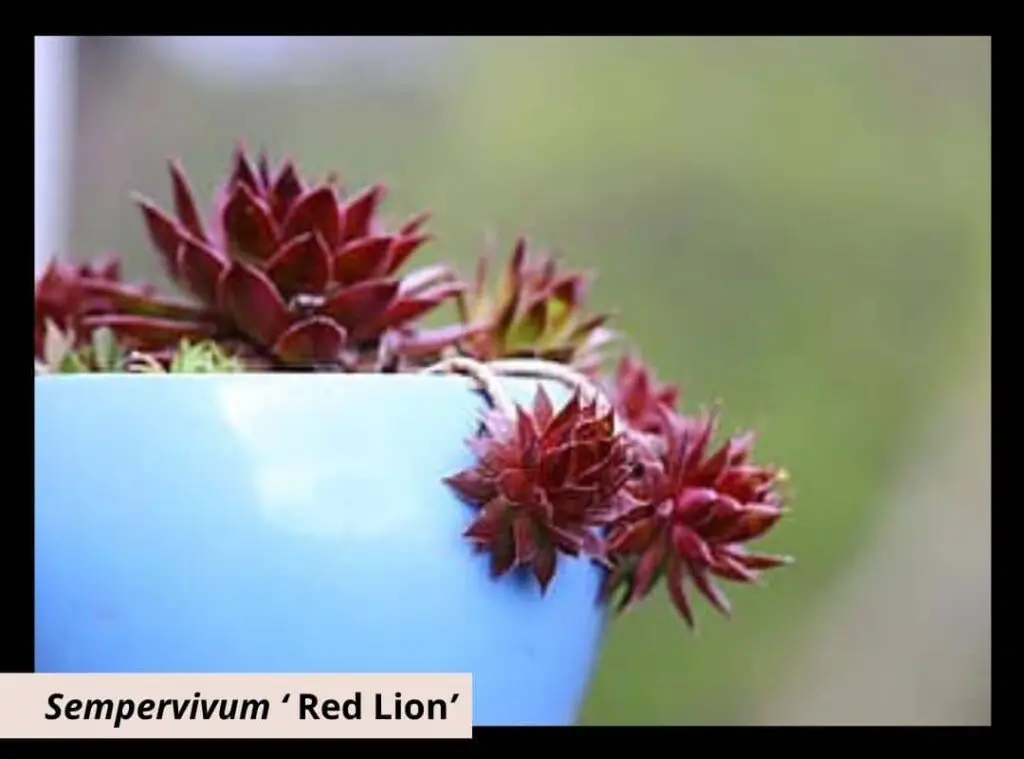
Sempervivum ‘Red Lion’ plants come up with Rosset which you could spot in rich red
Chances are that you could spot them carrying leaf tips in green along with yellow shades too. Red lions are cold hardy plants.
As such you could grow them outdoors or even in landscaping projects if you live in a colder place. USDA hardiness zones 5-10 would perfectly suit these plants to thrive well.
Red Lions rosettes would be about six inches in width when it is fully matured. These plants generate offsets, and they would usually grow in dense clumps.
Further they would consist of small hairs which have grown across the leaves surface and that gives them the look of a lion moniker.
They are suitable for outdoor gardening as they could withstand frost situations. Having said that, they would be handy as indoor plants as well.
Sedum rubrotinctum ‘Aurora’
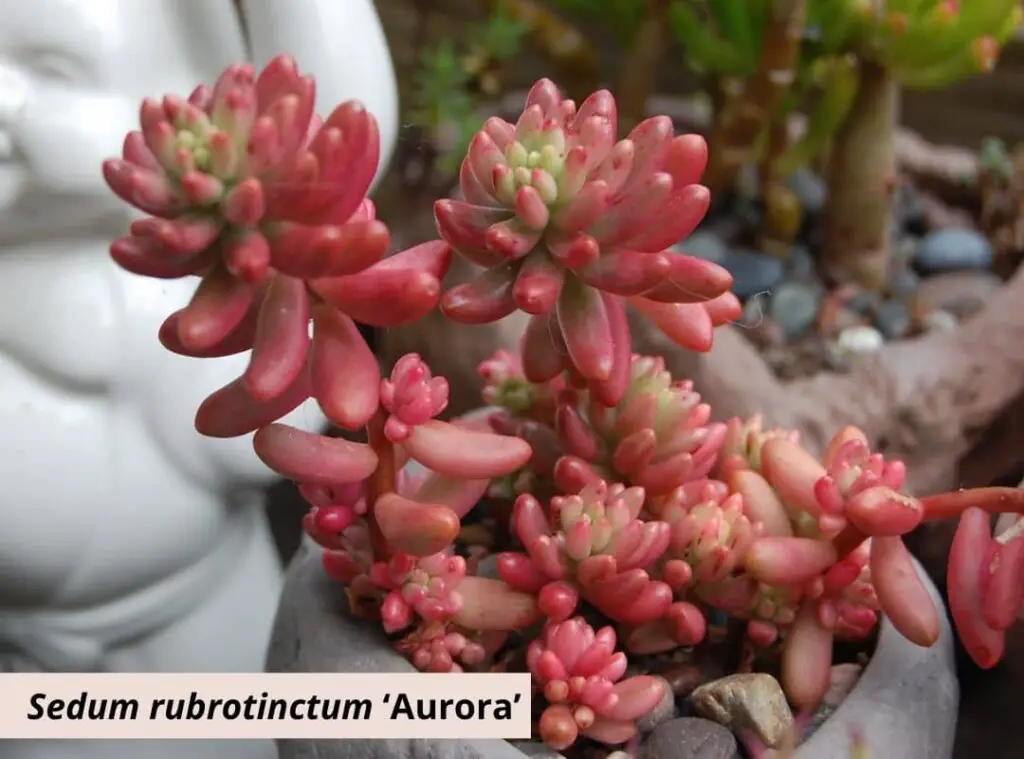
Sedum rubrotinctum ‘Aurora’ plants have plump and fleshy leaves. Further the leaves tend to form around the stem in a spiral manner.
Stems would grow up to 8 inches in height. Those leaves will further consist of pink or red colored tips. Their color will intensify if they get more sunlight exposure. They tend to grow rapidly.
They would be great as fantastic accent plants particularly when you grow them along with other succulents.
You may even grow them with the rest of other red succulents as well. You could grow them indoors and outdoors.
However, when you grow them outdoors, avoid exposing them for frost conditions. Aurora plants are endemic plants to Mexico.
USDA hardiness zones 9-11 are the perfectly fitting zones for these plants.
Sedum ‘spurium red’
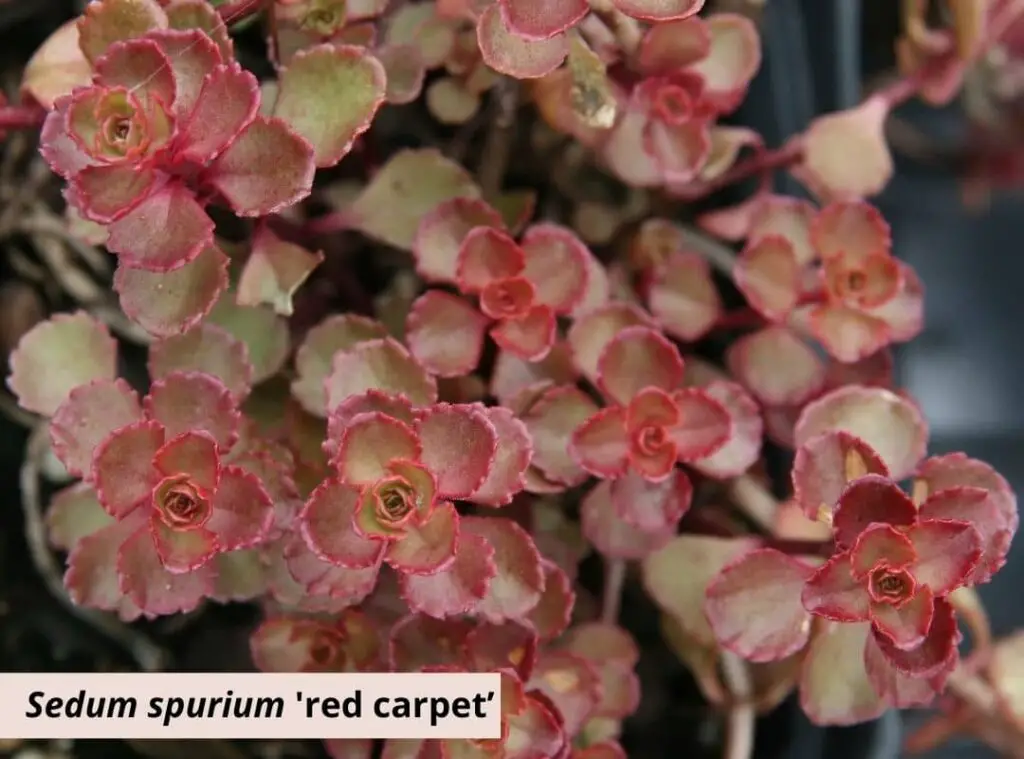
Sedum spurium red is a stunning Sedum variety which is well known for its dense ground hugging red foliage.
They would usually carry a deeper shade of red right throughout the fall and winter. Further chances are that they could produce small blooms in pink in early summer.
They would be about 4 inches when it is grown to its fullest potential. . On the other hand, their width would be about 18 inches.
These plants ‘preferred USDA hardiness zones are 3 through 9. These are native plants in Georgia. They could fit in for both indoor gardening and for outdoor gardening as they can withstand almost any light level.
Sedum ‘Stonecrop Voodoo’
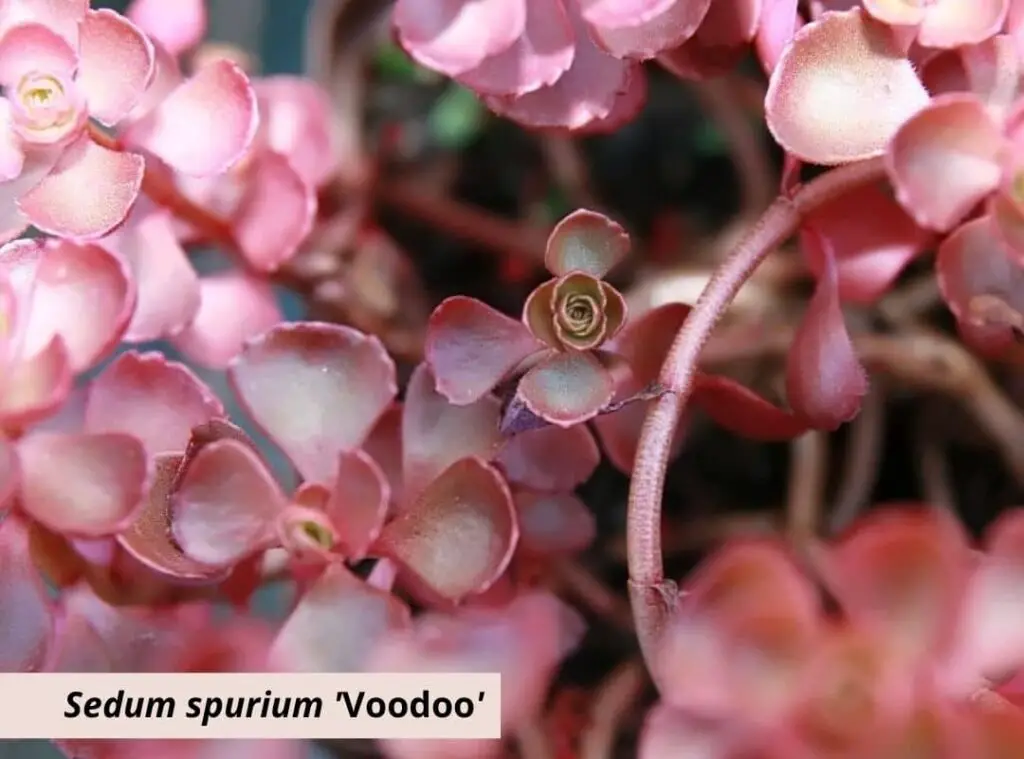
Voodoo sedum Stonecrop are hardy in USDA hardiness zones 3-9.
When it comes to the sizes of the plants, they would be 4-6 inches in height and 1-2 inches in width. These are mat forming semi evergreen perennial plants.
They would produce leaves which are fleshy along with deep red shades.
They would produce rose pink flowers during summer. They would be handy to use as ground covers and as potted plants too.
They would consist of round leaves which you could spot in brick red during spring. Further they would turn burgundy in color along with gray shades too.
Euphorbia tirucalli ‘Sticks on fire’
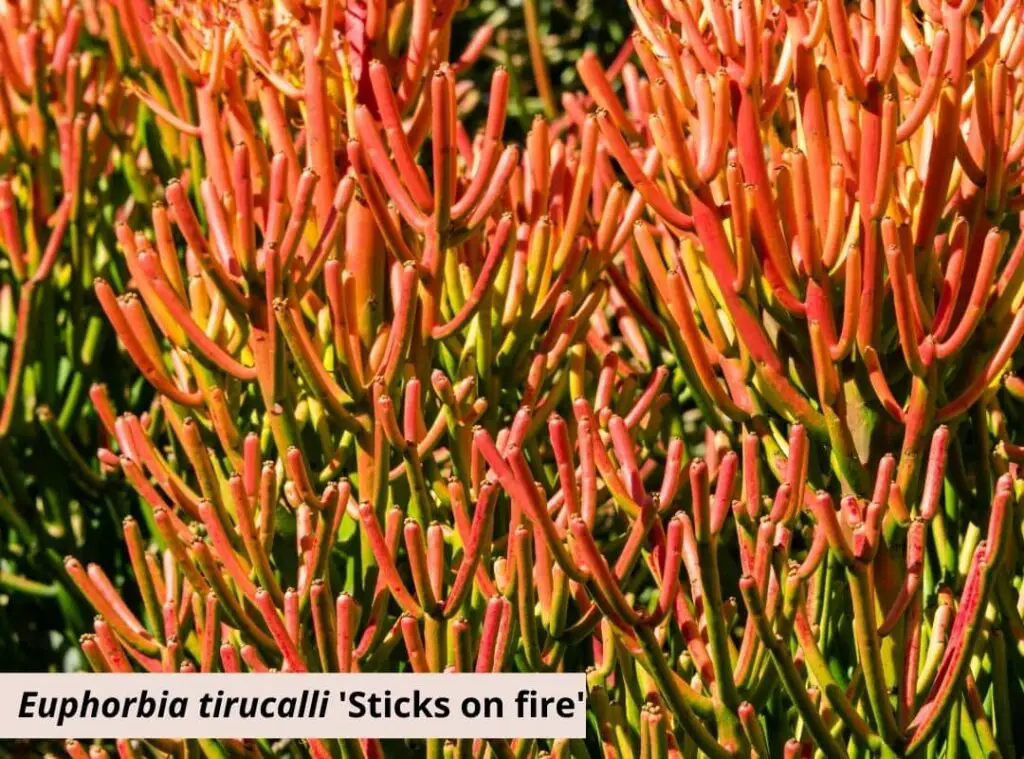
Euphorbia tirucalli would rise to 40-80 inches in height as well as in width. These plants consist of a thicket of beautifully colored stems.
Further you could spot them branching vertically which gives a thin pencil look. This is why they have inherited the common name called pencil cactus.
USDA hardiness zones 10-12 are their preferred hardiness zones. They originate from Eastern and Southern Africa.
These plants are suitable for indoor gardening as well as outdoor gardening. However, you need to let those plants gain adequate sunlight though.
Learn more about this plant here.
Euphorbia trigona ‘Royal Red’
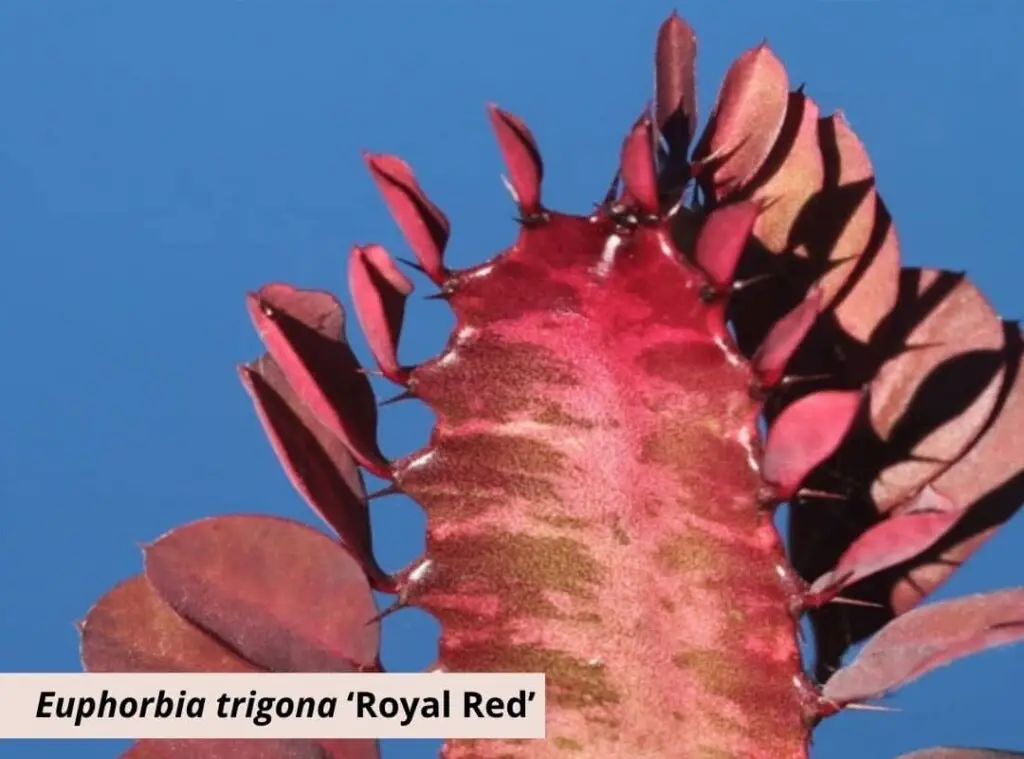
Royal Red plants are unusual succulents which you could spot growing in lovely bright red color. They could rise to 6 feet maximum in height.
Further chances are that they could even expand into a shrub. Further royal red is regarded as a good luck charm too.
You could spot the stems being covered with long spines. Further the colors of the stems would be green, yellow to deep burgundy.
In addition to that, those stems would be covered with green, red leaves too.
You could grow them anywhere be it indoors or outdoors. For example, you can grow them as outdoor plants if you live in frost free areas.
Royal red plants are fast growing plants. If you expose them for bright sunlight, that will help their foliage to become deep burgundy in color.
They would prefer to grow in 10a-11b USDA hardiness zones. They are endemic plants in west Africa.
Cryptbergia ‘Red Burst’
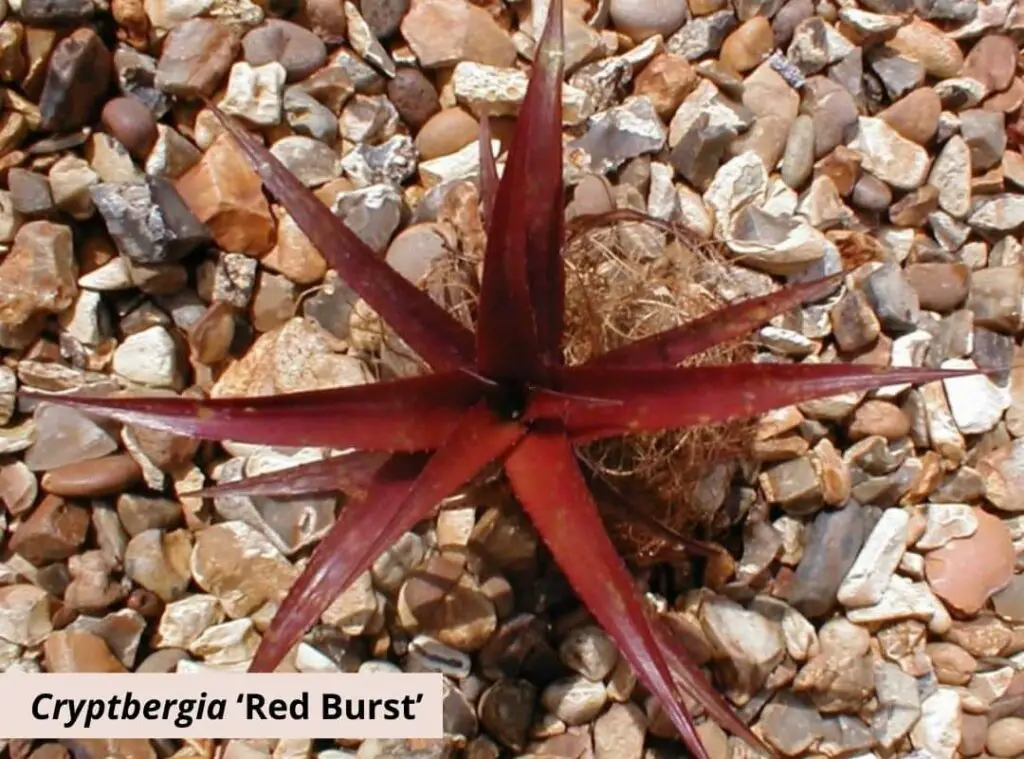
These plants are endemic to South Africa. Further red burst is an intergeneric bromeliad hybrid of a cross between Billbergia nutans and Cryptbergia bahianus.
They would form Rosset which will have a length of 8-12 inches. Further they will consist of long pointed leaves in green and in red.
They generally produce white flowers. However you could spot it very occasionally though . Red Burst plants usually grow freely.
Further chances are that you could spot them forming in clumps as well. These plants would prefer to grow in USDA hardiness zones 11.
Red Burst plants are native plants in South America. You may grow them indoors or outdoors as you wish. However, ensure that you provide the right growing conditions for them.
Aloe cameronii ‘Red aloe’
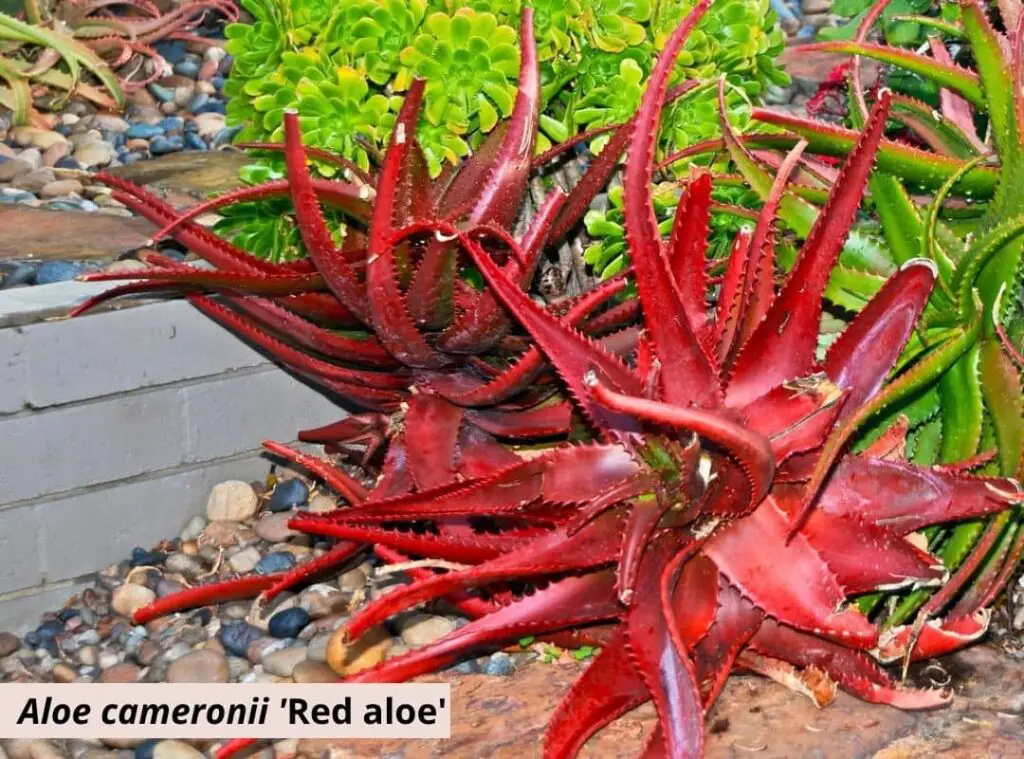
Aloe cameronii plants would grow upto 12-24 inches in height and their spread would be for about 24-36 inches.
They are renowned as a slow growing set of plants. They also form with a red shade. If you manage to provide bright sunlight, they will flourish with copper red foliage.
Aloe cameronii is one of the most beautiful plants in the Aloe species. . These plants fall under USDA hardiness zones 9-12.
They are suitable for both indoor gardening and for outdoor gardening. Aloe cameronii plants are native plants in Africa.
Kalanchoe luciae ‘Paddle Plant’
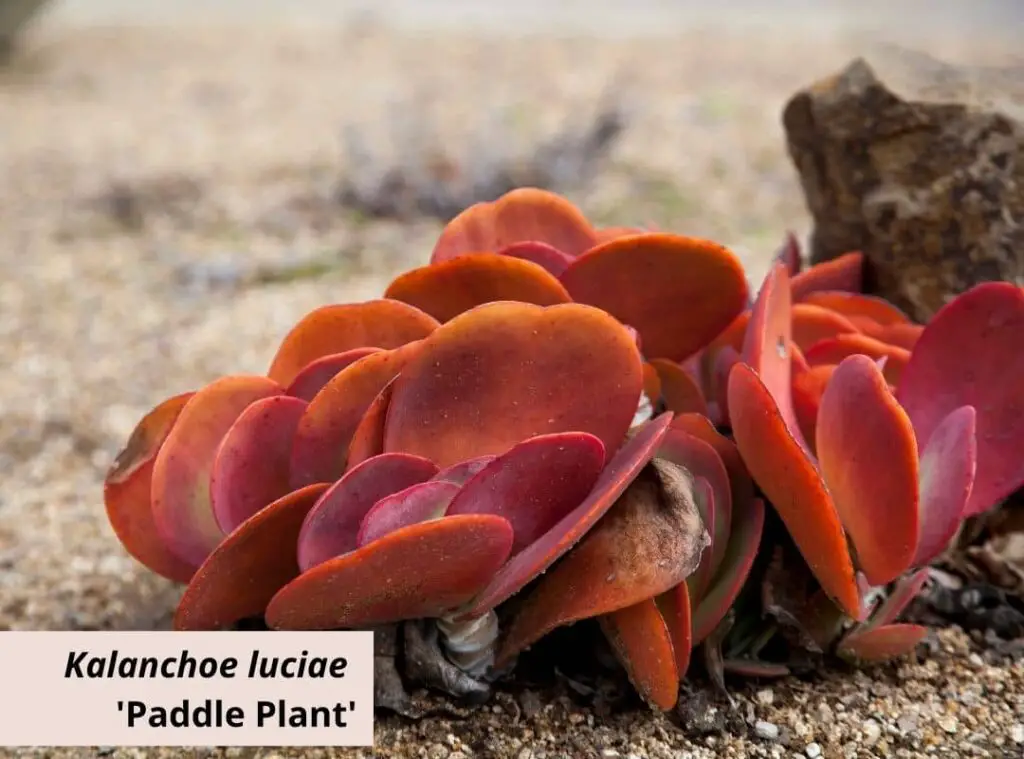
Kalanchoe luciae are native plants in Mozambique. They are fast growing plants. Kalanchoe luciae will produce round disk-shaped leaves.
They would be grey in color. Further Kalanchoe luciae could consist of leaf margins in red during cooler months.
The more you expose these plants for sunlight the more reddish they would become in color. These plants form in rosette type.
Kalanchoe luciae plants fall under USDA hardiness zones 9-12. They do well both indoors and outdoors.
However, make sure you are providing them adequate sunlight when growing them indoors.
They will flower with yellow green blooms. You could spot Kalanchoe luciae forming solitary or growing in clumps. They would be about 12-16 inches in height and 12-14 inches in width.
lithops karasmontana ‘red top’
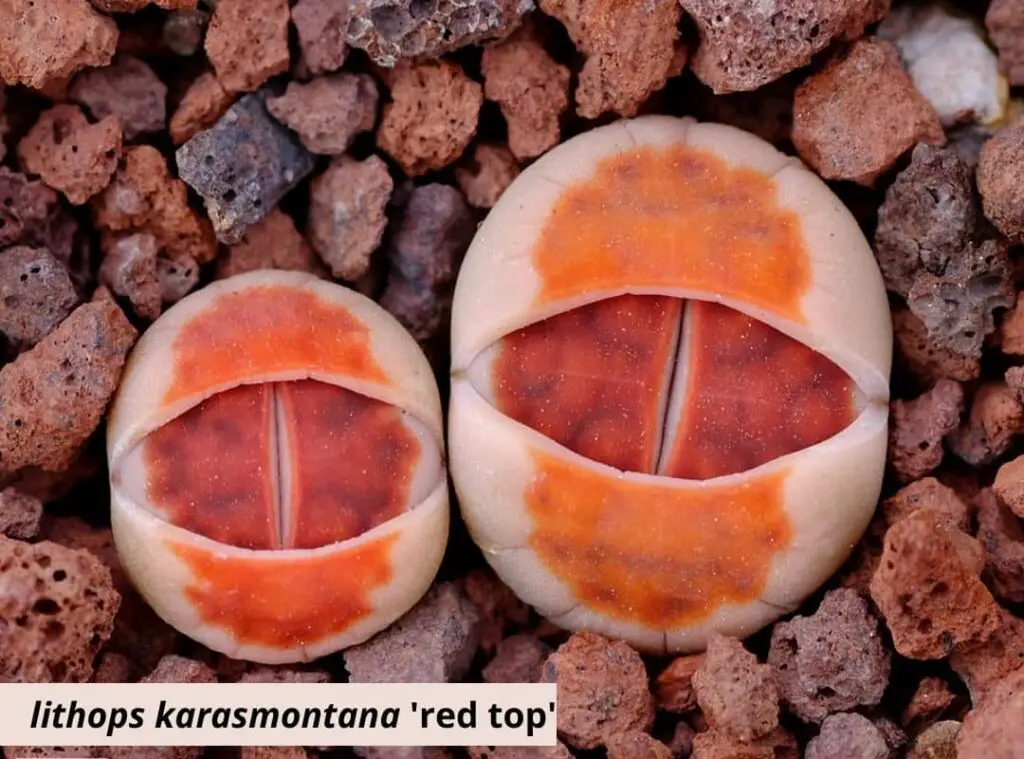
Lithops karasmontana red top plants tend to form in clumps. In terms of the sizes, they would be about 2 inches in height.
Further their spread would be indefinite. Lithops karasmontana’s leaves form in pairs. Further those leaves will form as two gray stones with red mottling on the flat surface.
Lithops karasmontana would produce flowers in white during fall. Their preferred USDA hardiness zones are 10a-11b.
Lithops karasmontana are a slow growing set of plants. Hence you could grow them as perfect houseplants indoors.
In addition to that they could thrive well outdoors as well. On the other hand, you could spot the matured lithops growing in a form of pebbles in the containers.
In terms of the origin, they are a cultivator of Lithops karasmontana.
Aeonium ‘Medusa’
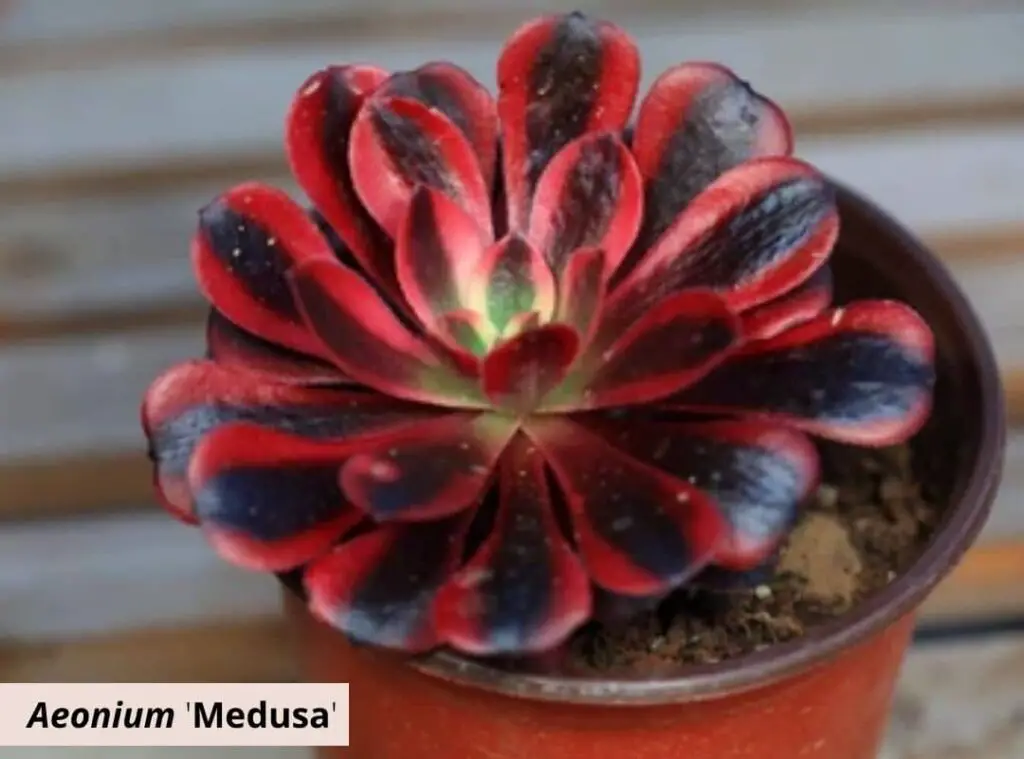
Aeonium Medusa plants are a stunning set of variegated plants. This is a variegated form on Aeonium Velour which is coming from Holland.
They would become a hot red color during summer. Once they approach the winter season, their leaves’ edges become creamy white in color.
They will also form in a rosette type. Further you may spot layers of branches right below the rosette.
In terms of the sizes, they would be 45 cm tall and 40 cm wide. You may grow them indoors and outdoors as you wish given that you provide the right growing conditions.
Echeveria ‘dick wright’
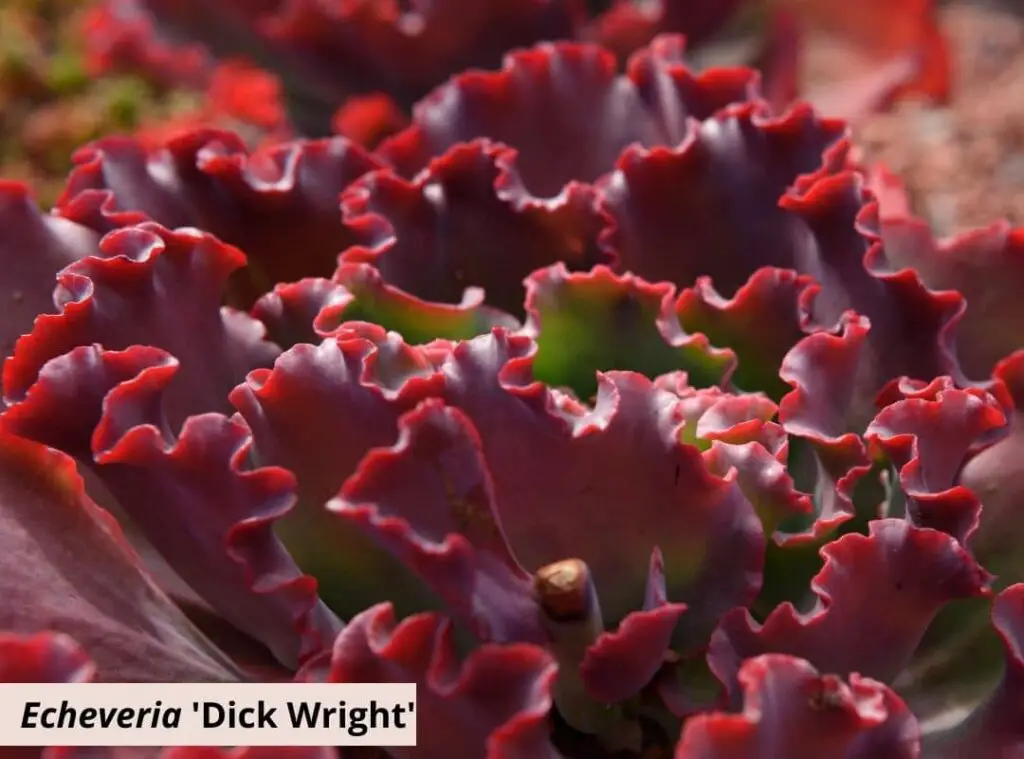
Echeveria is a popular succulent with lot of verities. This beautiful red succulent is a hybrid of Echeveria. Popular succulent farmer Dick Wright develop this amazing succulent in 2014.
The wavy rose petal like leaves of Echeveria ‘dick wright’ bring your home a unique vibe.
Conophytum burger ‘Burger’s onion’
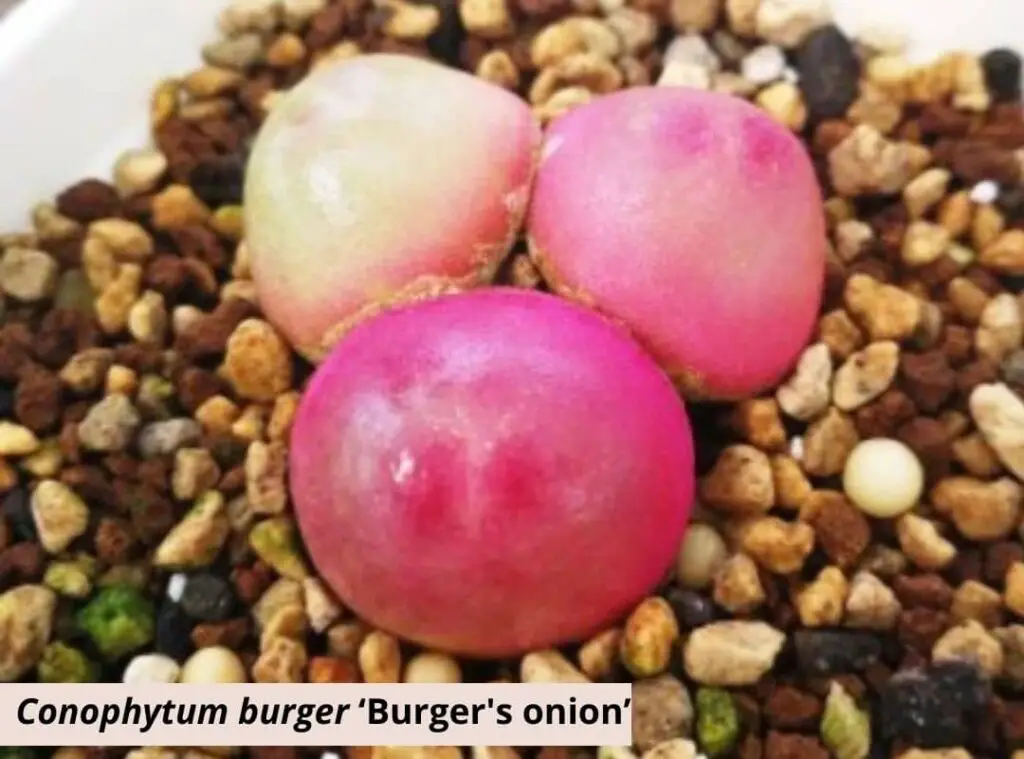
The Conophytum burger resembles the look of an onion. Further you could spot them forming in pale green.
They would grow upto 2.5 cm wide.Further Conophytum burgers would bloom with purple flowers during early autumn.
C.burger plants are hardy in USDA hardiness zones 1b-11b. You may grow them in cute looking pots indoors.
Moreover, they are suitable to grow outdoors as well. Conophytum burgers are endemic to South Africa.
Tillandsia ionantha ‘Air Plant’
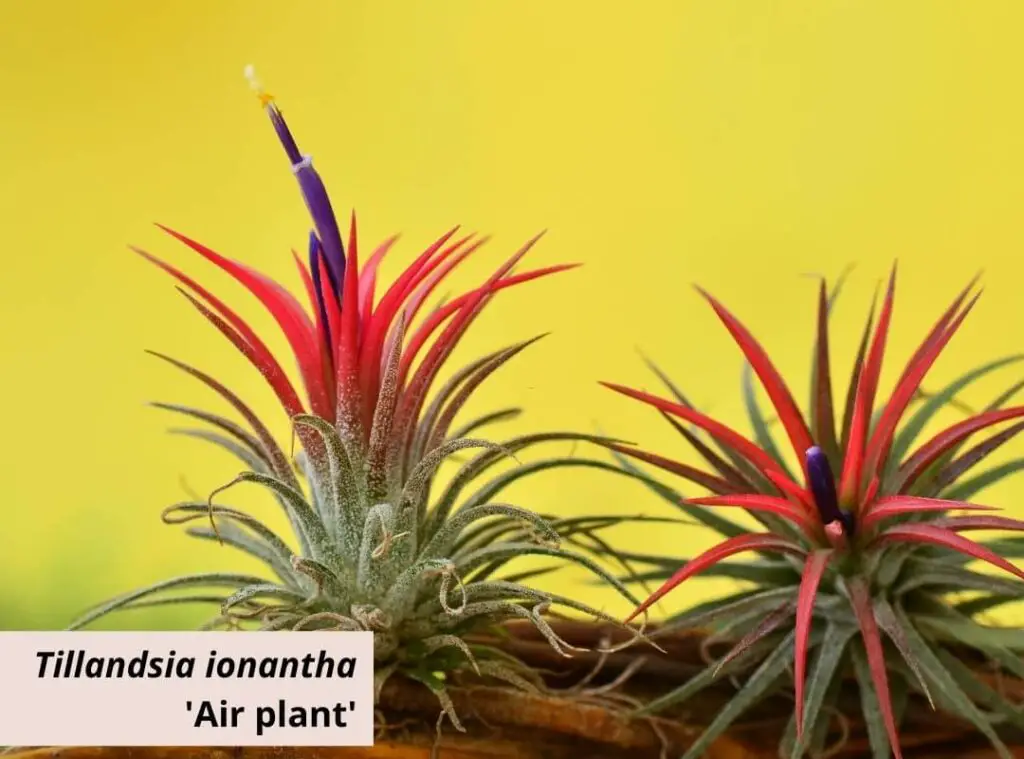
Air plants form long fragile leaves. Further you could spot them growing in silvery green color When they approach the blooming season, they form stunning red shade in the plant.
Further they will produce lovely violet-colored flowers. If you expose them for direct sunlight, it will enhance the red hues.
Air plants are not dependent on soil to grow. As such you may place them anywhere be it indoors or outdoors.
In terms of the sizes of the plants, their height would be around 2-4 inches and the width would be around 3- 4 inches.
These plants fall under USDA hardiness zone 11. Central America and Mexico are their native countries.
Read More: Jellyfish Air Plant | A Beautiful Combination of Nature And Creativity |
Kalanchoe sexangularis ‘Six-angled Kalanchoe’
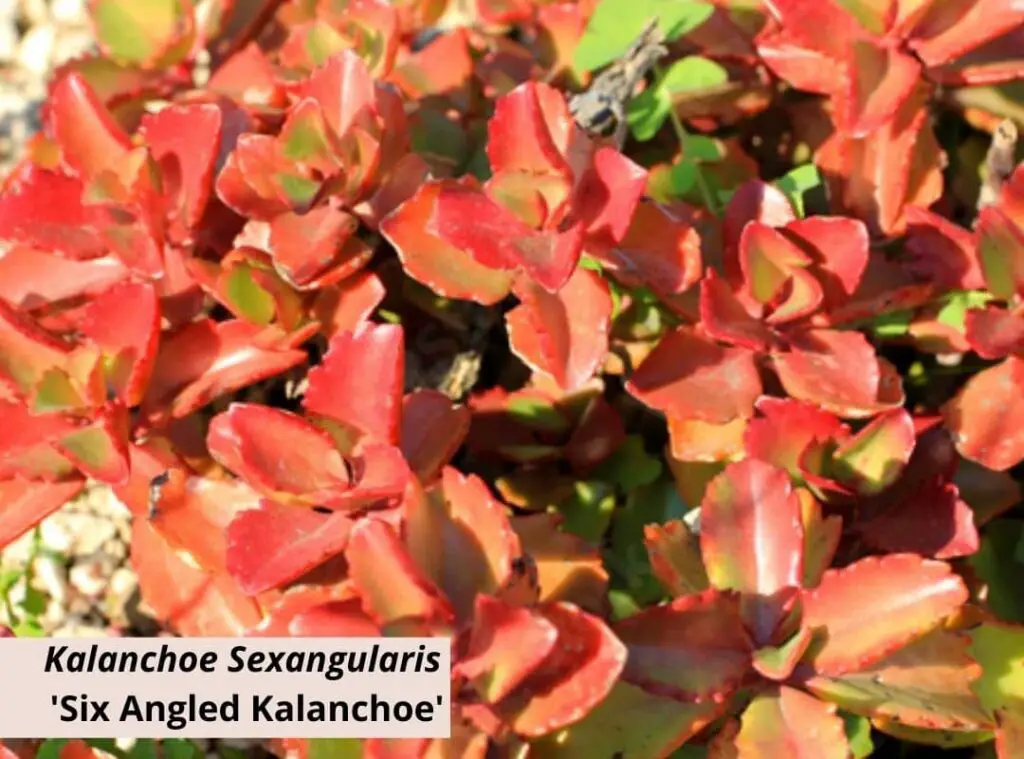
Kalanchoe Sexangularis consist of a red foliage. They could be great picks for rockery gardens and for patios as well.
Literally you may grow them indoors as well as outdoors. This is more like an evergreen succulent shrublet. They usually grow in an upright manner.
These plant stems could be spotted in green when they are immature and later on, they will turn brown and flaky when they are older.
Chances are that their stems would become droopy and lax when their leaves become larger in size and become heavy.
USDA Hardiness zone 9a-11b are the perfectly fitting hardiness zones for them. These are native plants in Southern Africa.
They would stay under 1.5m in height and further it could have an unlimited spread as well. They would consist of foliage which is broad glossy and deeply serrated.
When you grow these plants in shade, chances are that you could spot their leaves in green red. On the other hand, if you expose them to bright sunlight, they will become ruby red in color.
In addition to that if the plant is going through any drop in temperature, they would still turn red.
Phedimus spurius ‘dragon’s blood’
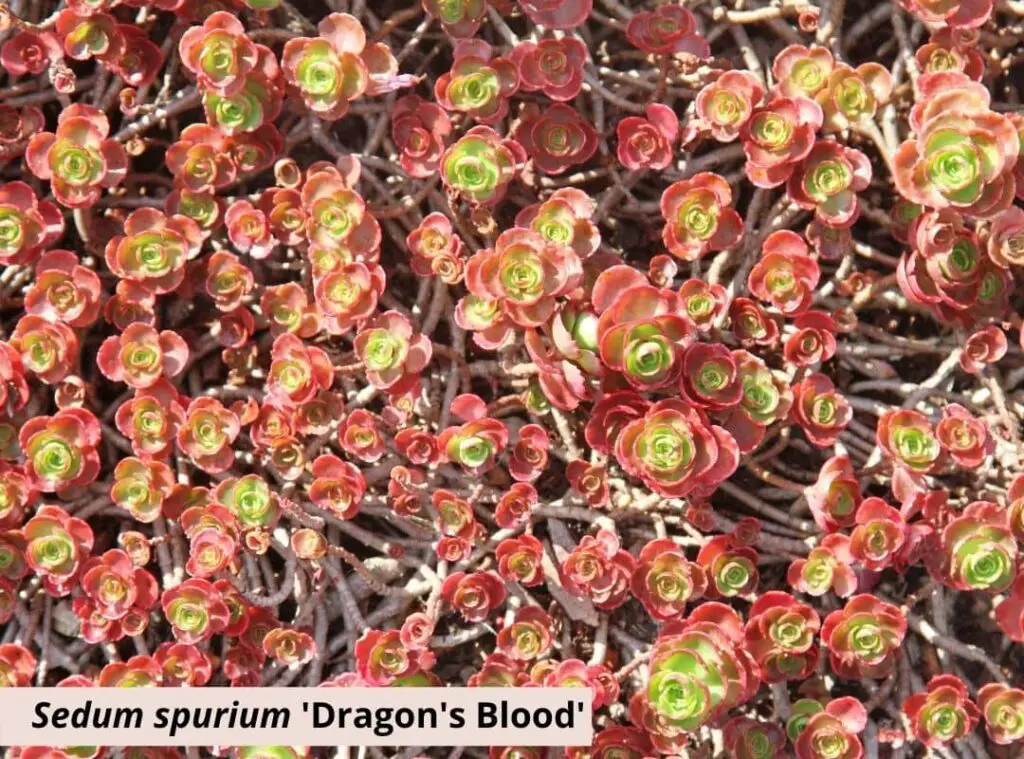
Dragon’s blood plants are a stunning plant which could come up with a colorful foliage. They could be about 4 inches tall and 18 inches wide.
Their stems could be spotted in a creeping manner. Further you could spot them rooting at the nodes too.
USDA hardiness zones 4-9 would perfectly fit in for these plants. They are originally from Germany. They would suit both indoor gardening and outdoor gardening.
However, when you grow them indoors, expose them for adequate sunlight.
Mammillaria spinosissima ‘Red-Headed Irishman’
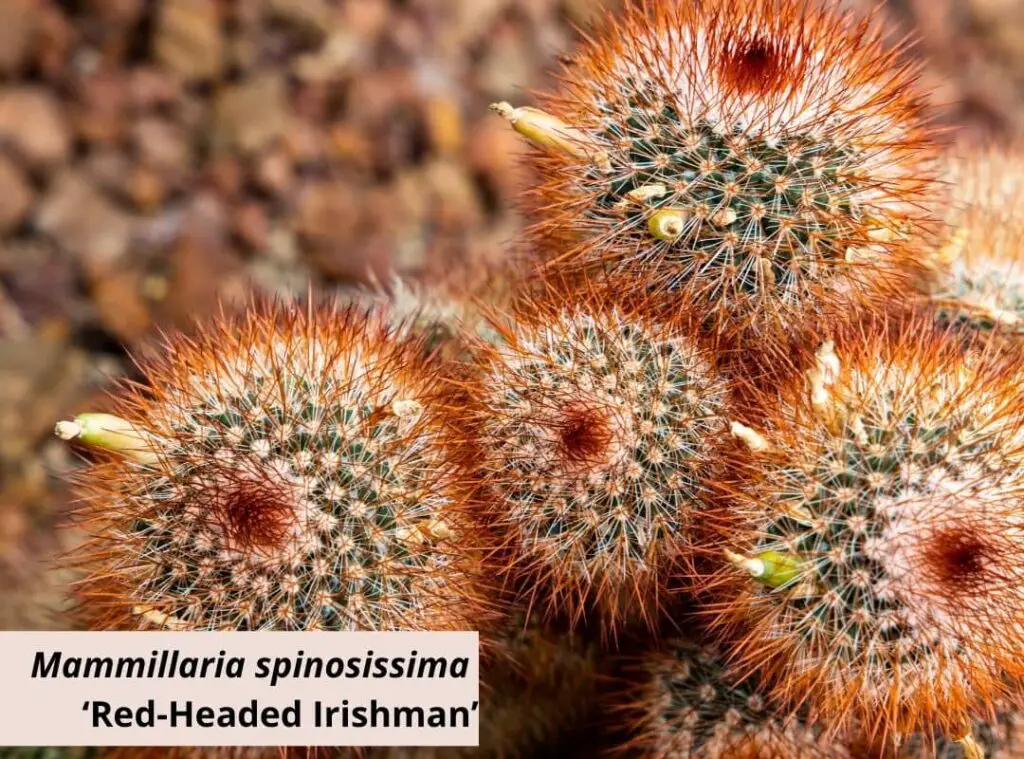
Red headed Irishman plants are cactus type. These plants tend to take a look of globe shape. They would produce flowers in bright red – pink.
Their stem would be deep blue green in color. Further those stems would be about 12 inches in height. Further Irishman plants would be about 4 inches wide.
Their stem would be covered with orange red spines. That is why they have inherited this nickname called red headed Irishman.
These are native plants in Mexico. USDA hardiness zones 9a-11b are their preferred hardiness zones. They are suitable for both indoor gardening and for outdoor gardening.
Ferocactus pilosus ‘Mexican Lime Cactus’
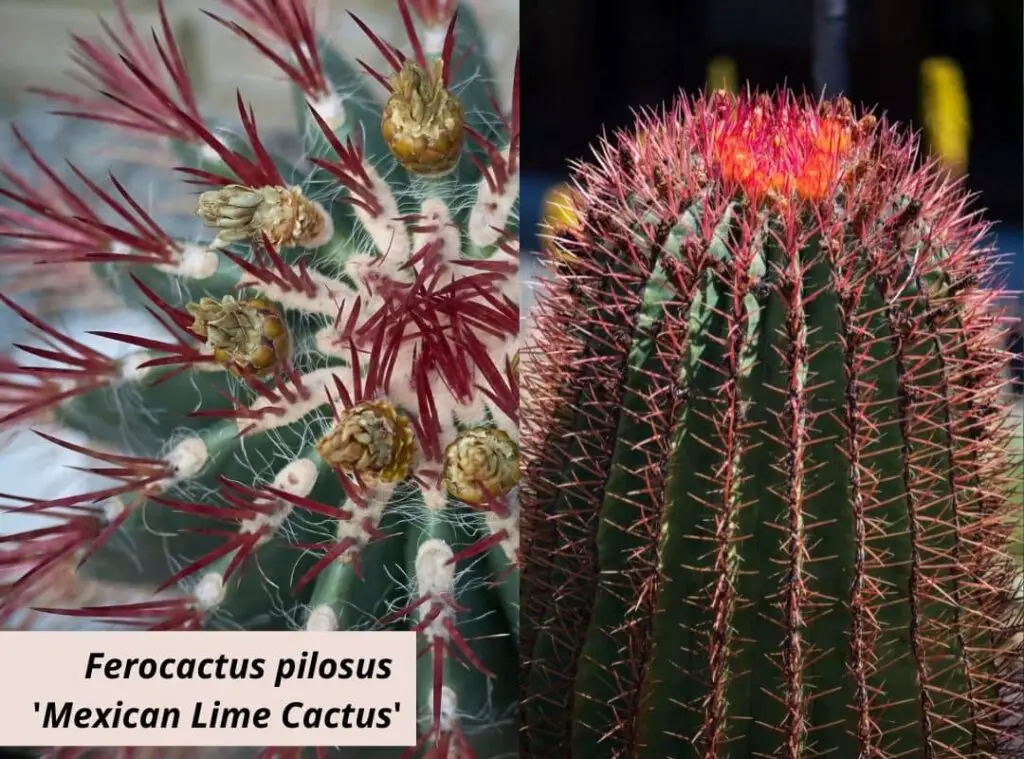
Ferocactus pilosus are native plants in Mexico. They tend to grow in clumps along with red spines. Further their stems could be spotted in deep green These are round in shape.
Moreover they will consist of red thorns as well. These plants would be 2.4(-3) m in height and 30-40 cm in width.
You could spot them growing in yellow to red colors. In terms of the hardiness zones, these plants would prefer to grow in zone 9b-11b.
Agave ‘Red Edges’
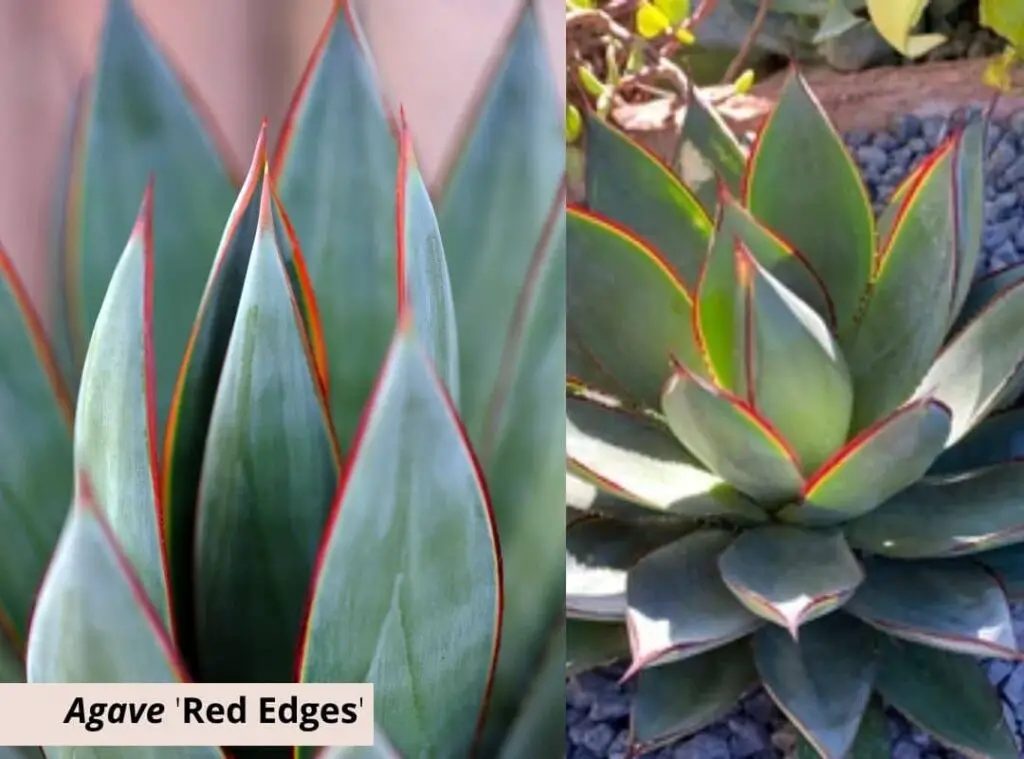
Agave Blue Glow plants usually tend to grow slowly. They could thrive well anywhere, be it indoors or outdoors.
This is a hybrid of an Agave attenuata and Agave ocahui. They would rise to 45 cm – 60 cm in height.
Further their leaves would be blue-green in color. Further they form in rosette type along with an agglomerated growth manner.
Their leaves would consist of red spines as well. Usda hardiness zones 9-11 would suit these plants the best.
Aloe ‘Crosby’s prolific’
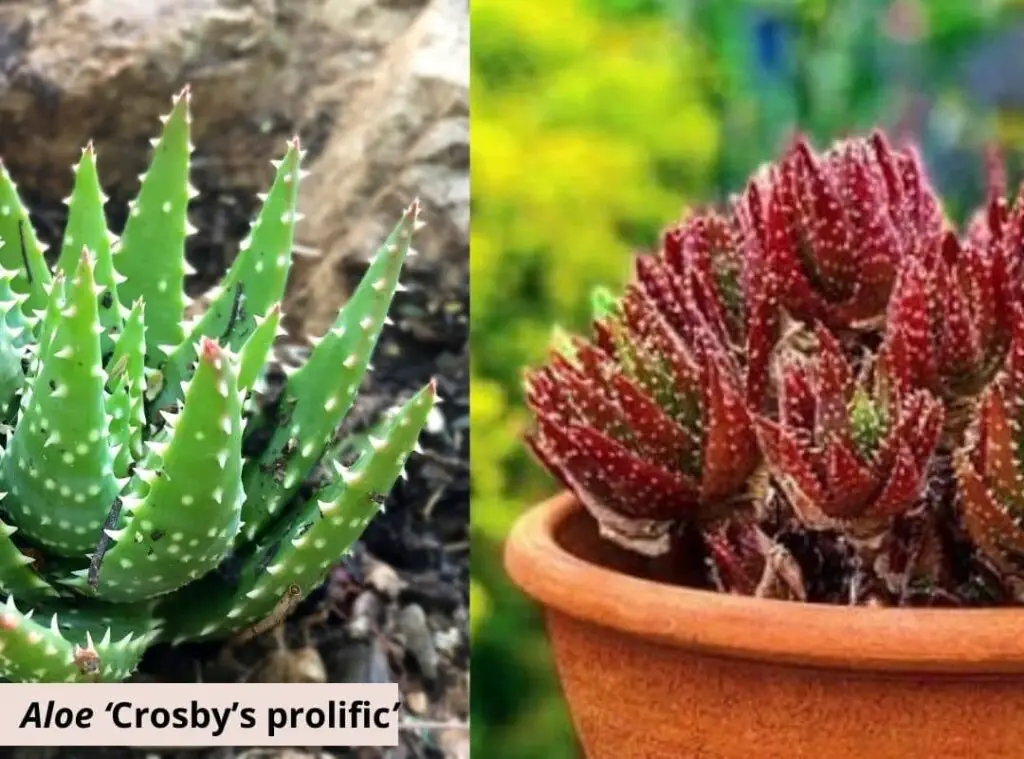
Aloe Crosby’s prolific plants could rise to 6-8 inches in height and 9-12 inches in width. These plants also tend to form in rosette types along with deep green foliage.
You need to expose them to bright sunlight so that they can become more red and orange in color.
Their leaves would be green to light green in color, and you could spot sharp teeth on the edges of the leaves. Their leaves would be lance shaped.
Aloe Crosby’s prolific plants would produce flowers in bright orange. This plant is a result of a cross between Aloe nobillis and Aloe humilis var echinatum.
They would prfer to grow in Usda hardiness zones 9-11.
Crassula capitella ‘Red Pagoda’
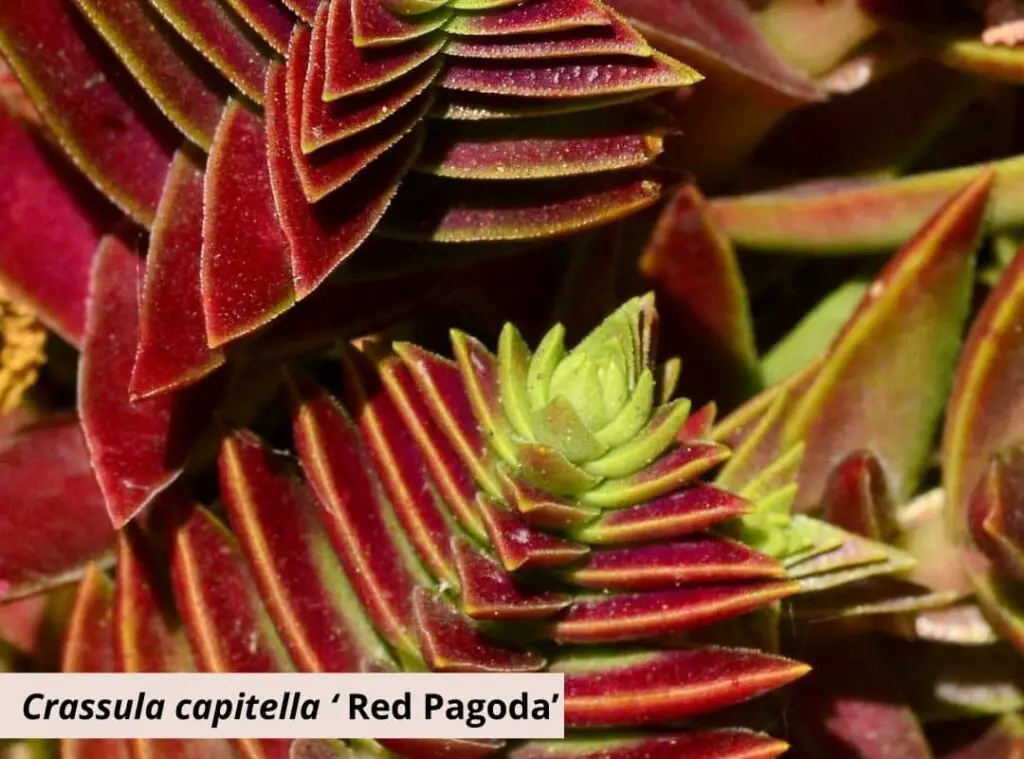
Crassula capitella ‘Red Pagoda’ are stunning red succulents. Red pagoda plants produce triangular leaves which form into towers and it makes them look like pagoda towers.
You could spot these plant leaves’ inner parts in green which are in contrast to the outer leaves’ darker red color.
Red Pagoda leaves are thick too. Further these plants are endemic to South Africa. You could grow them indoors at a bright sunny spot.
Usually, their stems would be about 8 inches long. You could grow them outdoors as well. However you need to protect them from frost conditions.
Particularly if you have summer conditions right throughout the year, you may grow them as perfect groundcovers. Apart from that Red Pagoda plants leaves form covering their stems.
Read More: Crassula Capitella ‘Red Pagoda’ Ultimate Care Guide | 16 Things To remember |
Sedum stahlii ‘mexican sedum’
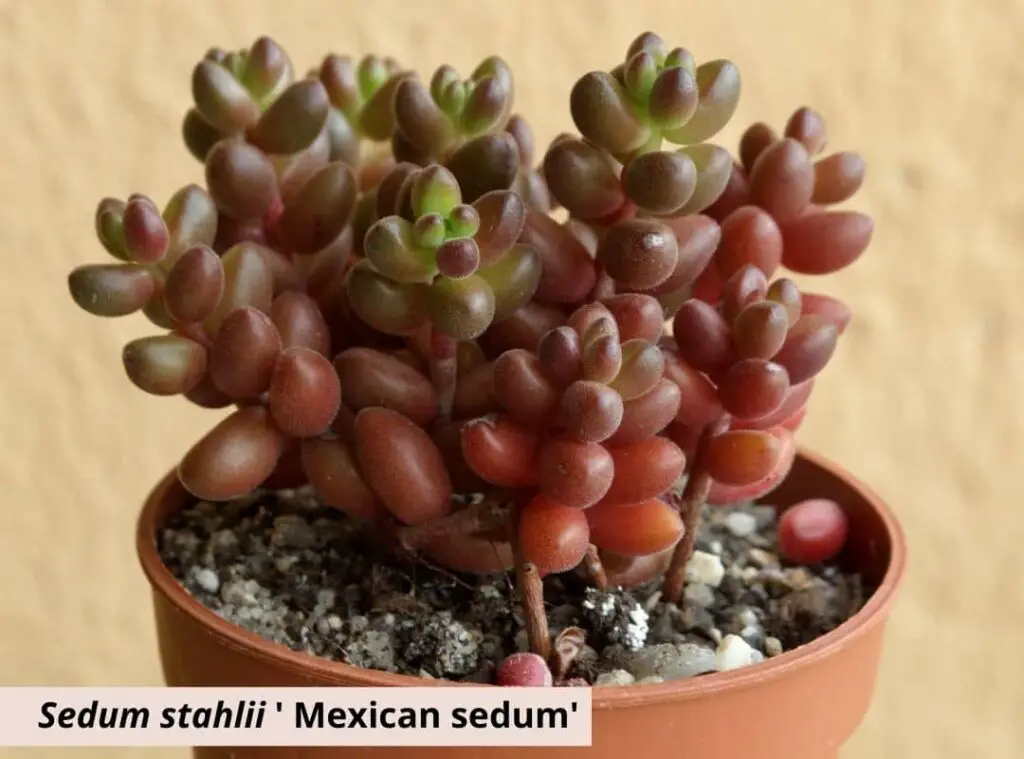
Sedum stahlii are native plants in Mexico. This is an evergreen succulent which we can use as a ground cover.
They could be about 5-25cm in height. They have fleshy leaves which tend to look like eggs. Sedum stahlii will grow in an opposite manner.
Moreover, they would be dark red to russet green in color. Their leaves are very fragile and they tend to drop at the slightest touch.
You could expect them to flower with star shaped bright, yellow-colored blooms during spring and in summer.
These plants would tend to have spreading, trailing branched stems which you could spot in reddish brown in color.
Those stems would be hairy too. Sedum stahlii’s preferred USDA hardiness zones are 7b-11b.
Aloe ‘Christmas Sleigh’
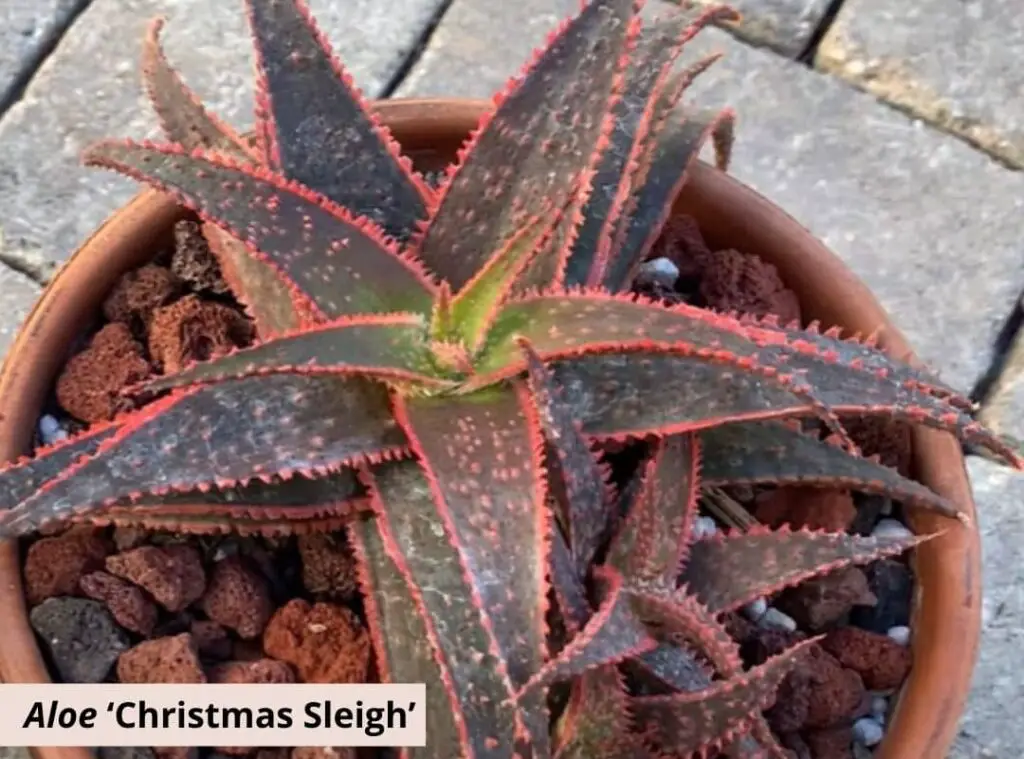
Aloe Christmas Sleigh plants usually comprise dark green colored leaves along with thorns which you could spot in bright red to orange.
If you were wondering about adding a color touch to your garden, Aloe Christmas Sleigh would suit your requirement. Their growth pattern would tend to look like starfish.
You may grow them indoors or outdoors. Be it a container garden or outdoor landscaping. In terms of flowering, they would produce flowers with bright red, pink during fall.
On the other hand, Aloe christmas Sleigh plants would rise to 4-7 inches in height and 5-6 inches in width.
Read More: Aloe Christmas Sleigh Care And Propagation Guide | 15 Care Secrets |
Sempervivum Heuffelii ‘Chocolate Sundae’
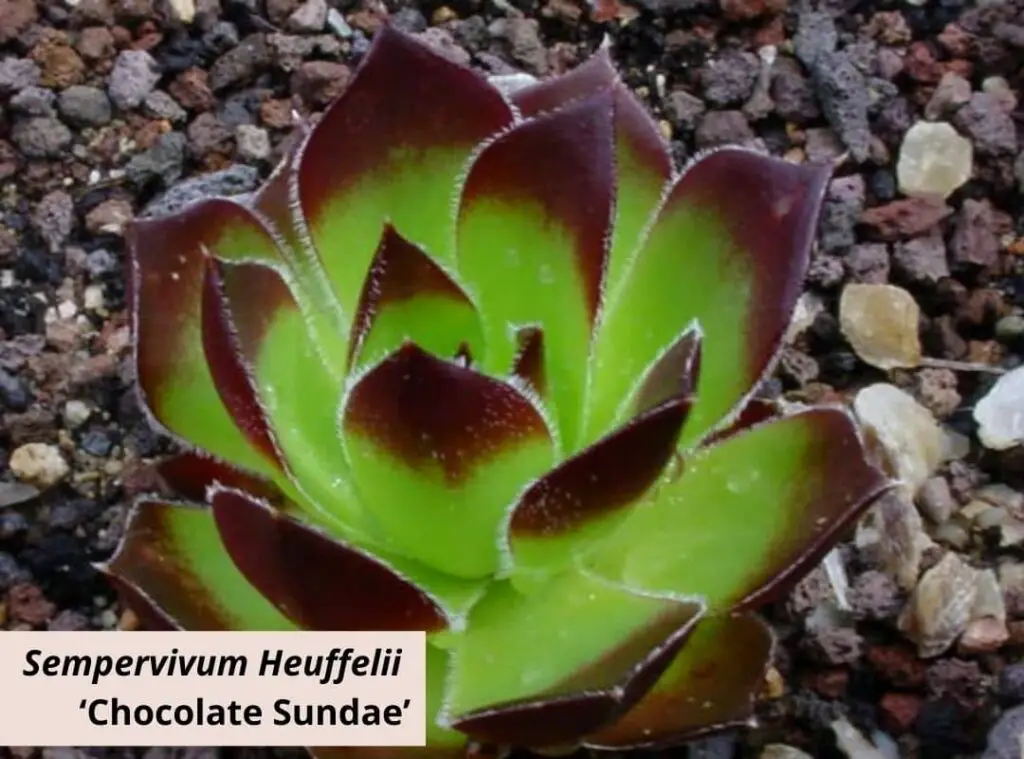
Chocolate sundaes are hardy species. They could stay in the red and green color all year long.
Moreover, if you expose them to bright sunlight, their red color would be intensified. Chocolate sundae plants would grow up to 1-2 inches in height.
In terms of the width, they would be about 3-4 inches.
They would perfectly fit in as both outdoor plants and as indoor plants. Further they will grow in little colonies without depending on any other.
USA hardiness zone 4 is their preferred hardiness zone. They could thrive well outdoors throughout the year. Having said that, you may grow them indoors as well.
Sempervivum ‘red rubin’
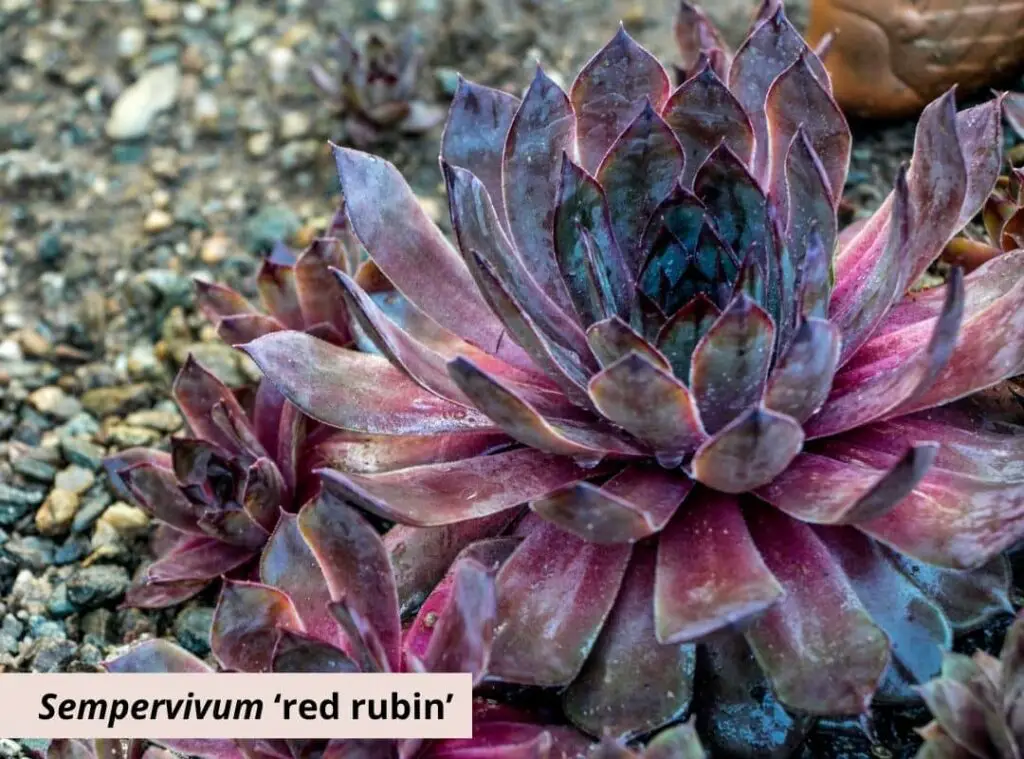
Sempervivum red rubin plants could rise to 4-6 inches in height. On the other hand, their spread would be about 9-12 inches.
You could spot them forming with large evergreen rosettes, those rosettes would be fleshy and emerald, green in color.
Further you could spot them coming up with margins in red as well. Usually, their color will intensify during cool temperatures.
These fall under USDA hardiness zones 3-8. These plants are native plants in southern Europe and in Western Asia.
You may grow them indoors and outdoors. For example, they would be handy to use for ground covers, containers, beds and for borders also.
Echeveria sp el Encino
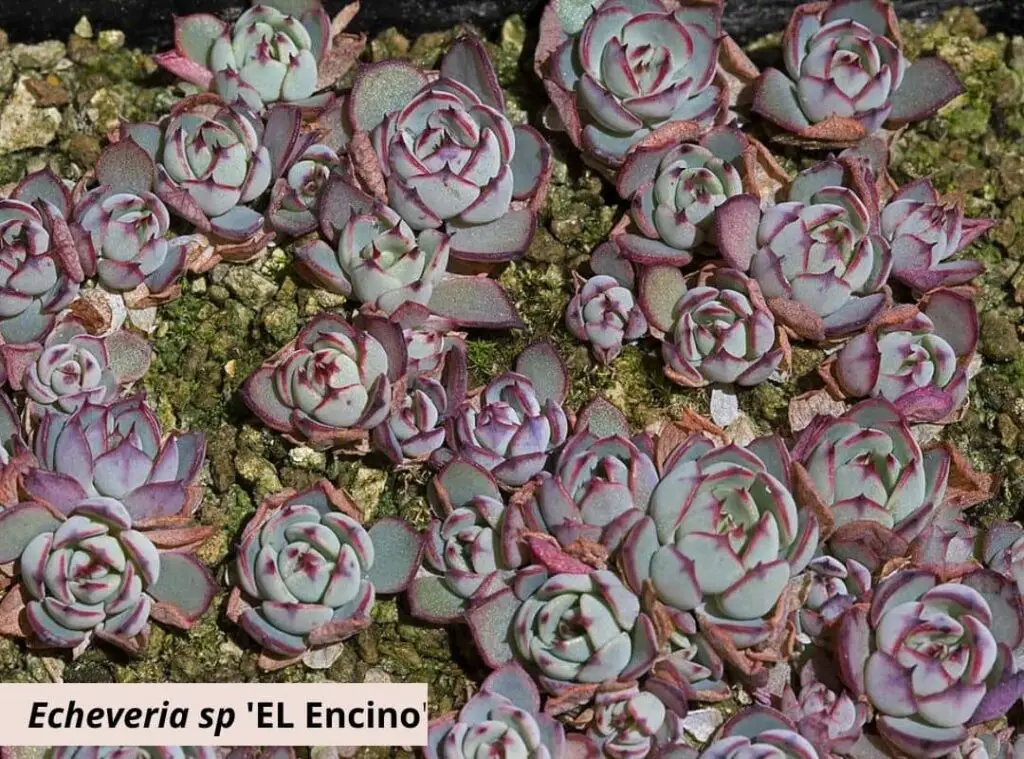
These plants form in fabulous Rosset along with various colored leaves.
Related Question
How do I get my succulents to turn red?
To make your succulents turn red, you need to expose them to bright sunlight for all day. Alternatively, you may expose them to 6 hours of sunlight daily so that they can become stressed.
What does a red succulent mean?
It means these succulents have been exposed to extreme conditions in sunlight, temperature levels etc.
Further if you spot any red succulent, that could be a result of under watering and insufficient nutrients and poor-quality soil too.
Literally if your succulents are in stress, they will change the colors. They change colors as a response to the environmental changes.
Conclusion
I hope this article was useful and now you have a better understanding of what you need to exactly own.
When you are growing any of these red succulents, you need to make sure that you are providing adequate sunlight for them.
In addition to that, you should water them moderately when their soil is dry too. When you adhere to these steps, these plants will become more vivid in their reddish color.
You may select a succulent which has a scarlet, burgundy or merlot color depending on your wish and I am sure that you will not be disappointed with the flourishing of the plants.
Read Next
White succulent | 15 Unique White Succulents For Your Garden |
Black succulents | 13 Unique Black Beauties For Your Garden |


